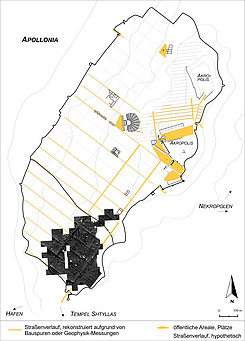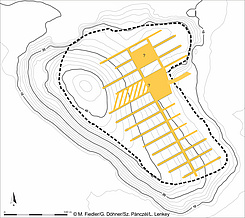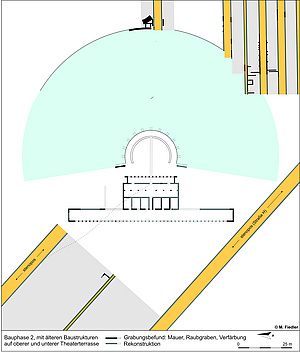Investigations in Apollonia (Albania)
Apollonia belongs among the most important cities along the Adriatic Sea. Its favourable geographical location established the city’s prosperity as found in written sources as well as in monuments and in material remains. Archaeological investigation of the city began already a hundred years ago. Since 1992 a French-Albanian equipe invesitgates parts of the upper town, publishing the »Atlas d’Apollonia« in 2007. It contains the plan of a re-investigated municipal area and summarises the investigations performed so far.
German-Albanian Investigations in Apollonia
A German-Albanian cooperation founded in 2006 under the lead of Henner von Hesberg and Bashkim Lahi, concentrated on the exploration of the theatre that was exposed in the 1960ies but never concluded and published. Reconstruction and history of this building was at the centre of the investigations, still questions emerged regarding the way in which the city was founded and expanded and also regarding some individual monuments.
The exploration of a neighbouring settlement near Babunjë led to the conclusion that the colonisation of the east coasts of the Ionian Sea and the Adriatic Sea must have been a multi-layered process that besides the big colonies also included smaller settlements in order to consolidate the colonial structures.
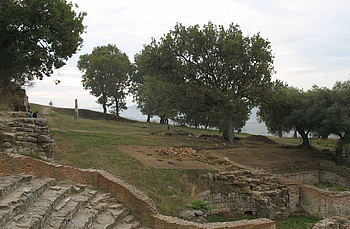
For the Lower Town from the Classic period, geophysical investigations in Apollonia account for an extraordinary generous structure with Insulae of 59 x 153,5 meter; they contrast with the narrow allies and Insulae in the upper town from the Archaic period, that can also be identified in Babunjë.
In the Hellenistic period in Apollonia a new public centre was established, structured into several artificial terraces at the foot of the Acropolis. Subsequent excavations at a Stoa and the investigation of a so-called Amphora-Wall were able to date this expansion phase into the third century BC.
The Theatre of Apollonia
During that time, in the middle of the third century BC, one of the largest theatres in the Greek northwest region was built in the city’s centre. Like a hinge this building fits into the street system between Lower and Upper Town: with this theatre-axis there was reference to the Upper Town, the width of the porticus post scaenam was incorporated into two neighbouring streets of the Lower Town. The theatre occupied a natural recess at the city’s western slopes which were extensively changed by earth-works in order to obtain a regular auditorium. Older residential buildings had to give way to the new public building. In addition, a drainage system was installed, since spring water and surface water represented a danger to the building’s stability.
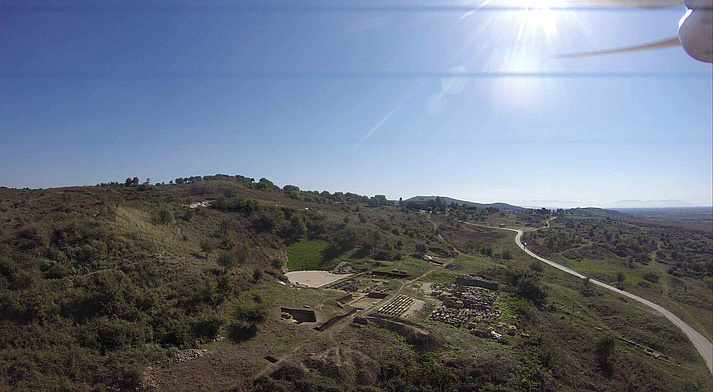
The Construction Phases
Excavations performed between 2006 and 2016 stated six construction phases. Phase 1 encompasses the construction of the koilon with the circumference of 120 m. The floor plan of the stage building can be reconstructed mainly from the robber trenches. In the east the proskenion was placed. In Phase 2, a porticus post scaenam was added to the stage building (fig. 5). Its 77 m width protruded well beyond the width of the skene. The porticus facade, combined with the huge auditorium probably had an extraordinary effect on the viewers who approached the city from the west. The theatre was part of a cityscape expanded at the latest in the Hellenistic period.
In the Roman imperial era the building experienced two fundamental transformations allowing for gladiator competitions to take place. In Phase 3 a tall balustrade was erected between koilon and orchestra, in construction phase 4 the skene was dismantled in favour of a larger arena. Earth cellar and recesses are witnesses of temporary installations for these competitions. After a brick building was erected and changed again to replace the skene during phase 5 and 6, the theatre arena of Apollonia obviously perished following an earthquake in the middle of the third century BC.
Literature
A. Angelinoudi – J. Bäuerlein, Das Theater von Apollonia (Albanien). Ein Vorbericht, Römische Mitteilungen 114, 2008, 17–29.
M. Buess – M. Heinzelmann – St. Steidle, Geophysikalische Prospektionen in der südlichen Unterstadt von Apollonia (Albanien), Römische Mitteilungen 116, 2010, 205–211.
B. Lahi – M. Fiedler, Ausgrabungen im Zentrum von Apollonia (Albanien). Vorläufige Ergebnisse zu der sog. Amphorenmauer und ihrer Umgebung, Römische Mitteilungen 116, 2010, 213–255.
M. Fiedler – St. Franz – Sh. Gjongecaj – H. von Hesberg – V. Hinz – B. Lahi – Sz.-P. Pánczél – F. Quantin – E. Shehi – B. Shkodra-Rrugia, Neue Forschungen zum hellenistisch-römischen Theater von Apollonia (Albanien), Römische Mitteilungen 117, 2011, 55–200.
M. Fiedler – H. von Hesberg, Apollonia (Albanien) in der Zeit des Hellenismus: Eine Stadt zwischen italischem Westen und griechischem Osten, Athenische Mitteilungen 127/128, 2012/2013, 213–258.
B. Lahi – H. von Hesberg, Apollonia, the Theatre, in: I. Gjipali – L. Përzhita – B. Muka (Hrsg.), Recent Archaeological Discoveries in Albania (Tirana 2013) 84–87.
H. von Hesberg, Nuove indagini intorno al teatro di Apollonia, in: G. Tagliamonte (Hrsg.), Ricerche archeologiche in Albania: atti dell’Incontro di studi, Cavallino-Lecce, 29–30 aprile 2011 (Rom 2014) 201–217.
St. Franz – V. Hinz, Das Theater von Apollonia (Illyrien/Albanien). Neue Forschungen zum hellenistischen Koilon und seinem römischen Umbau, Bericht über die 47. Tagung für Ausgrabungswissenschaft und Bauforschung: 16. – 20. Mai 2012 in Trier (Stuttgart 2014) 93–100.
M. Fiedler – H. von Hesberg, Mauerbauinschriften der Apolloniaten aus Leukas, Archäologischer Anzeiger 2014/2, 59–74.
H. von Hesberg, Ein Amazonenfries aus Apollonia, in: D. Graen – M. Rind – H. Wabersich (Hrsg.), Otium cum dignitate – Festschrift für Angelika Geyer zum 65. Geburtstag: Studien zur Archäologie und Rezeptionsgeschichte der Antike, BAR international 2605 (Oxford 2014) 13–22.
M. Fiedler, Aspekte der städtebaulichen Entwicklung Apollonias. Die deutsch-albanischen Forschungen 2006–2013, in: L. Përzhita u. a. (Hrsg.), Proceedings of the International Congress of Albanian Archaeological Studies. 65th Anniversary of Albanian Archaeology, Tirana 21.–22. November 2013 (Tirana 2014) 253–265.
St. Franz – V. Hinz, The Architecture of the Greek Theatre of Apollonia in Illyria (Albania) and its Transformation in Roman Times, in: R. Frederiksen – E. R. Gebhard – A. Sokolicek (Hrsg.), The Architecture of the Ancient Greek Theatre: Acts of an International Conference at the Danish Institute at Athens 27–30 January 2012 (Athen 2015) 335–349.
H. von Hesberg – M. Fiedler – B. Toçi, Skulpturenfragmente archaischer und klassischer Zeit aus Apollonia (Albanien), Jahrbuch des Deutschen Archäologischen Instituts 133, 2018, 49–185.
M. Fiedler – G. Döhner – S.-P. Pánczél, Babunjë: eine spätarchaisch-klassische Kleinsiedlung zwischen Apollonia und Dyrrhachion (Albanien), in: L’Illyrie méridionale et l’Épire dans l’Antiquité. Actes du VIe colloque international en Musée National de Tirana 2015 (Clermont-Ferrand, 2018) 1003–1016.
M. Fiedler – E. Shehi – S.-P. Pánczél – G. Döhner, Die Kleinsiedlung Babunjë: neue Forschungen zur territorialen Siedlungsstruktur zwischen Apollonia und Epidamnos/Dyrrhachion (Albanien), Archäologischer Anzeiger 2019, 228–251.
Further Information
www.dainst.org/projekt/-/project-display/32986
Project Lead
Prof. Dr. Henner von Hesberg
Universität zu Köln
Archäologisches Institut
Albertus-Magnus-Platz
50923 Köln
E-Mail
Prof. Dr. Bashkim Lahi
Qendra e Studimeve Albanologjike
Instituti Arkeologjik
Sheshi Nene Tereza
Tirane
E-Mail
Staff
Manuel Fiedler (excavation lead), Stefan Franz, Valentina Hinz (construction research), Eduard Shehi, Brikena Shkodra-Rrugia, Klodian Velo, Gregor Döhner, Szilamér Pánczél (excavation work and find handling).
Funding
This project is funded by the German Archaeological Institute in Rome, the Deutsche Forschungsgemeinschaft (DFG) and the Bavarian Academy of Sciences and Humanities.

